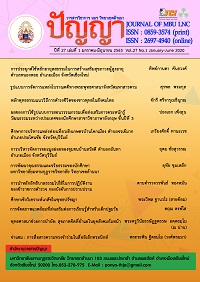THE LITERATURE INSTRUCTIONAL MODEL IN PROMOTING INTERCULTURAL AWARENESS OF THIRD-YEAR ENGLISH MAJOR STUDENTS AT THE FACULTY OF EDUCATION, BURIRAM RAJABHAT UNIVERSITY
Keywords:
the literature instructional model, , Intercultural awareness, the third-year English major studentAbstract
The Objective of this research were 1) to investigate the effects of the implementation in the literature instructional model in promoting students’ intercultural awareness 2) to examine the students’ attitudes towards the literature instructional model. The subjects were selected by a simple random sampling, and 24 the third-year English major students of academic year 2019. The research instruments were 1) the 9 ASEAN short story lessons 2) the intercultural awareness test 3) the questionnaire and the open-ended questionnaire 4) classroom observation. The paired sample t-test, mean, and standard deviation were used to analyze the quantitative data whereas content analysis and interpretation were used for the qualitative data.
The results of research were 1) there was a significant difference between the mean scores of pre- intercultural test and post-intercultural awareness test at a significant level of.05. The effect size was a large effect (1.350) and students’ awareness was at “intercultural awareness” level 2) the students expressed positive attitudes towards the literature instructional model. Besides, the results of classroom observation indicated that the majority of students changed their attitudes and perceived the similarities and differences of cultures after implementation of the literature instructional model.
References
ASEAN. (2009). Association of Southeast Asian Nations. Retrieved 9 July, 2019, from https://asean.org/asean/about-Asean/.
Baker, W. (2009). Intercultural awareness and intercultural communication through English: An investigation of Thai English users in high education. (Doctoral dissertation, University of Southampton).
Baker, W. (2012). From cultural awareness to intercultural awareness: culture in ELT.ELT Journal, 66(1), 62-70.
Chlopek, Z. (2008). The Intercultural approach to EFL teaching and learning. English teaching. Forum, 46(4), 10-19. Retrieved 10 December, 2019, from https://eric.ed.gov/?id=EJ1096289.
Choeichaiyapoom, P. (2013). Effect of English instruction using intercultural approach on intercultural awareness of upper secondary school students. (Master’s thesis, Chulalongkorn University).
Cohen, J. (1988). Statistical power analysis for the behavioral sciences (2nd ed.). New Jersey: Erlbaum.
Cronbach, L. J. (1974). Essential of Psychological Testing. New York: Harper & Row.
Bachelor of Education. (2017). English Curriculum, Buriram: Buriram Rajabhat University.
Furr, M. (2004). Literature circle for EFL classroom, Proceedings of the 2003 TESOL Arabia Conference. Arabia: Dubai.
Irawati, D. (2017). Effectiveness of Literature Circles on Students’ Reading Comprehension. IJOLTL: Indonesian Journal of Language Teaching and Linguistics, 1(3), 179.
Jauss, H. (1981). Toward an aesthetic of reception. Minneapolis: University of Minnesota Press.
Kaowiwattanakul, S. (2012). Preparing EFL Classroom for Asian Economic Community (AEC): Using Literature Circle to Promote Students’ English Language Skills, Critical Thinking Skills and Cultural Awareness, International Conference on Cultural and Linguistic Diversity in ASEAN. Bangkok: Suan Dusit Rajabhat University.
Kaowiwattanakul, S. (2019). Fostering EFL Students’ Global Mindedness at the Undergraduate Level through the Use of Literature Teaching Activity Based on a Reader-Response theory. PASAA PARITAT JOURNAL, 34, 136-153.
Karatay, H. (2017). The Effect of Literature Circles on Text Analysis and Reading Desire. Retrieved 19 December, 2019 from https://files.eric.ed.gov/ fulltext/EJ1155611.pdf.
Keshavarzi, A. (2012). Use of Literature in Teaching English. Procedia - Social and Behavioral Sciences, 46, 554- 559. Retrieved 9 October, 2019from https://www.researchgate.net/publication/271582388_Use_of_Literature_in_Teaching_English.
Leask, B. (2009). Using Formal and Informal Curricula to improve interactions between home and international students. Journal of studies in International Education, 13, 205-221. Retrieved 8 September, 2019, from https://journals.sagepub.com/doi/pdf/10.1177/1028315308329792.
Liao, M. Hs. (2019). Cultivating Critical Thinking through Literature Circles in EFL Context. Spectrum: Studies in Language, Literature, Translation, and Interpretation, 17(5), 89-116
Liu, C. (2016). Cultivation of Intercultural Awareness in EFL Teaching, Journal of Language Teaching and Research, 7(1), 226-232.
Masavisut, N. & Boccuzzi, E. (2008). The S.E.A Write Anthology of ASEAN Short Stories and Poems: The 30th Anniversary. New Jersey: Silkroad Agency.
Paran, A. (2008). The role of literature in instructed foreign language learning and teaching: An evidence-based survey. Language Teaching, 41(4), 465-496. Retrieved 18 September, 2019 from https://www.researchgate.net/ publication/231992110_The_Role_of_Literature_in_Instructed_Foreign_Language_Learning_and_Teaching_An_Evidence-Based_Survey
Rosenblatt, L. M. (1978). The reader, the text, and the poem: The transactional theory of the literary work. Carbondale, Illinois: Southern Illinois University Press.
The Office of Council of Rajabhat University President. (2011). A Study on the Preparation of Rajabhat University for Participation in the Building of ASEAN Community in 2011. Bangkok: The Office of Council of Rajabhat University Presidents of Thailand.
Varita, D. (2017). Improving Reading Comprehension through Literature Circles, English Education Journal (EEJ), pp.234-244.


